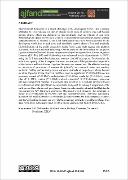Genetically engineered East African highland bananas –proximate analysis and effect of cooking on the enhanced provitamin A levels

View/
Date
2020-12Author
Walugembe, J.
Buah, S.
Runo, S.
Ateka, E.
Kubiriba, J.
Tushemereirwe, W.
Metadata
Show full item recordAbstract
Micronutrient deficiency is a major challenge in the developing world. This is mainly
attributed to over-reliance on starchy staples foods such as cassava, rice and banana
among others, which are deficient in micronutrients such as vitamin A and iron.
Strategies put in place to provide a solution to micronutrient deficiencies such as dietary
supplementation of vitamin A and food fortification have not been successful in the
developing world due to high costs and unreliable supply chains (food and medical).
Biofortification of the easily accessible staple foods could help reduce this problem
associated with micronutrient deficiency. On this account, the Biofortification project in
Uganda under the National Banana Program developed transgenic East African Highland
Bananas (EAHBs) (M9 and Nakitembe) with enhanced levels of provitamin A (PVA)
using the Fe’i banana-derived phytoene synthase 2a (MtPsy2a) gene. To determine the
nutritional quality of the transgenic bananas, an analysis of the proximate composition
of the biofortified East African Highland Bananas was carried out. The effect of cooking
on retention of provitamin A carotenoids (pVAC), was assessed using two cooking
methods; boiling and steaming (most common methods of preparing cooking banana
meals in Uganda). It was observed that there were no significant (P≤0.05) differences in
moisture content (P=0.4287), carbohydrate (P=0.3966), crude fat (P=0.4051), crude
fiber (P=0.3214), protein (P=0.0858) and ash content (P=0.1336) between transgenic
and non-transformed bananas. It was found that steaming, as a cooking method allowed
for retention of more provitamin A carotenoids compared to boiling. Comparison of the
cultivars on their retention of provitamin A carotenoids, results indicated that Nakitembe
was superior to M9. Genetic engineering of bananas by biofortification has no effect on
major food components in EAHBs (M9 and Nakitembe) and, therefore, genetically
modified M9 and Nakitembe are substantially equivalent to the non-transgenic controls
and the biofortified bananas can provide the necessary nutrients even after cooking. This
data will inform subsequent steps for the commercialization of biofortified EAHBs.
